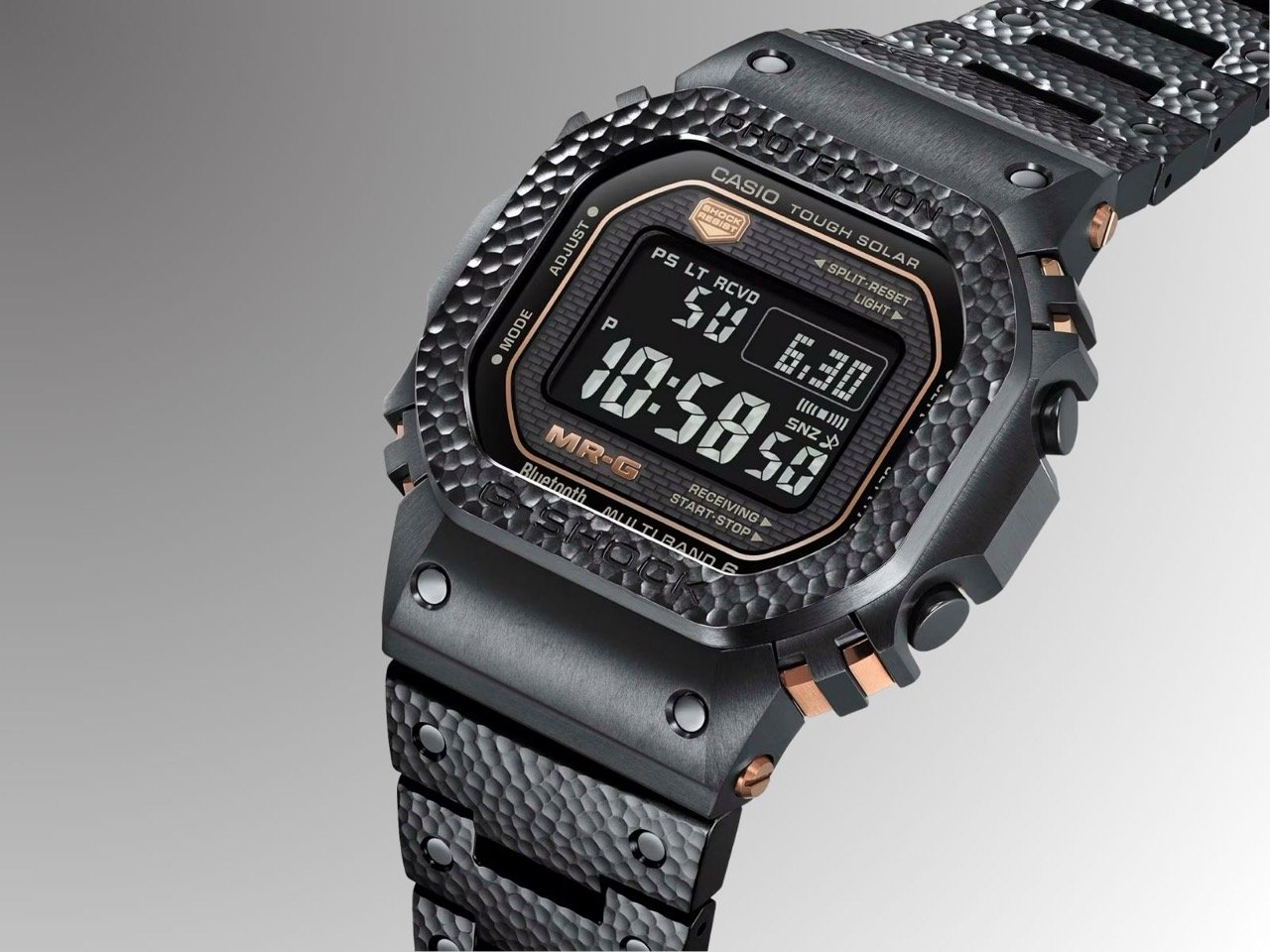Watches, dinnerware, and EDC have a pretty common overlap – sure, machine-made objects are great, but if they’re made by human hands, they’re valued and cherished more. A Swiss-assembled watch or a hand-forged Katana, or even a Japanese ceremonial teapot are much more respected than something churned along on a factory line. However, there isn’t really ever an overlap. Nobody makes watches out of Damascus steel, or katanas with variegated ceramic details, or teapots with intricate mechanisms… but Casio’s managed a workaround that brings hand-forged artistry to their watches.
The G-Shock MRG-B5000HT features a gorgeous “tsuiki” or a hammered texture on its bezel and body. Meticulously forged by a single Japanese master artisan, each watch brings that true handmade finish to life. Since the series is entirely made by hand, every watch has a unique hammer-print, giving each watch a bespoke visual identity. Each timepiece is crafted from titanium alloy, and finished with a black DLC coating that shows off that hand-hammered texture beautifully. Of course, given its handcrafted nature, the rollout of the watch is slow and limited to only 500 units. All this artistry comes at a price too – 935,000 yen (around US$6,387) to be specific.
Designer: Casio
Here’s where things get fascinating: the tsuiki technique completely rewrites the rulebook for mass-produced timepieces. Japanese metalworkers have been perfecting this hammering method for centuries, creating everything from temple bells to tea ceremony implements through thousands of controlled strikes. Kazuya Watanabe, the craftsman tapped by Casio, applies the same painstaking process to each watch component, building up those distinctive relief patterns that catch light differently from every angle. The skill required is genuinely impressive – only master artisans possess the muscle memory and precision needed to meet G-Shock’s exacting standards. Unlike machine-applied textures that look identical across every piece, tsuiki hammering introduces authentic randomness that makes each watch genuinely one-of-a-kind.
Casio chose DAT55G titanium for this timepiece instead of the Cobarion alloy found in other MRG-B5000 models. DAT55G offers three times the hardness of pure titanium while remaining malleable enough for hand-hammering, solving a fundamental materials challenge that lesser manufacturers would have ignored. The diamond-like carbon coating adds scratch resistance without interfering with the hammered texture’s visual impact. This titanium construction keeps the entire watch at just 112 grams despite the substantial bracelet, proving that premium materials can enhance rather than compromise wearability. The engineering balance between durability, workability, and weight demonstrates why G-Shock continues dominating the luxury tool watch segment.
Don’t worry – all that artisanal craftsmanship doesn’t come at the expense of actual functionality. The MRG-B5000HT packs every feature you’d expect from a flagship G-Shock: 200-meter water resistance, shock protection that could survive a building collapse, Bluetooth connectivity for smartphone integration, and Multiband 6 atomic timekeeping that syncs with radio signals from six global transmitters. You get world time for 31 zones, stopwatch functions, countdown timers, and multiple daily alarms. Solar charging means you’ll never need battery replacements, while the negative LCD display stays perfectly readable whether you’re in bright sunlight or dim indoor lighting. The technical package proves that artistic ambition and practical utility can coexist beautifully.
Kazuya Watanabe
Only 500 numbered pieces exist worldwide, launching first in Japan and Asia this August before trickling out to other markets based on demand. That 935,000 yen price tag ($6,387) puts this squarely in luxury territory, competing against Swiss mechanical chronographs and premium smartwatches. Collectors will undoubtedly devour available inventory quickly, especially given G-Shock’s proven track record with special editions and the genuinely labor-intensive production process. The pricing actually makes sense when you consider the handcraft involved and Casio’s positioning of this as a showcase piece for their manufacturing capabilities.
This watch succeeds because it respects both traditions – the ancient art of tsuiki metalworking and G-Shock’s modern durability legacy. The result feels genuinely special rather than merely expensive, offering something no factory-made timepiece can replicate: authentic Japanese craftsmanship applied to genuinely useful technology.
The post Casio ‘taps’ into Japanese Artisans for new hand-forged G-Shock Watches with manually hammered texture first appeared on Yanko Design.

